Application of Integrated Geophysical Methods in Urban Sewage Pipe Exploration
ABSTRACT: With the development of urban modernization, the detection of underground pipeline is increasingly difficult. The complex urban pipeline network, signal jamming and the limitation of fieldwork sites make the problem of urban engineering geophysical prospecting become unresolved with single geophysical methods. The integrated geophysical methods are therefore becoming the trend of urban geophysical prospecting. In this paper, we apply the integrated geophysical methods to a project of urban sewage pipe exploration in a site of Shanghai. The fieldwork site is limited, and the ground environment drastically changes. In this situation, the single geophysical method is not able to precisely track and locate the position of pipelines. Considering the ground condition and the features of geophysical methods, we combine the GPR with the high-density electrical method to locate the pipelines. The excavated underground situation coincides with detected result which suggests that the integrated geophysical methods are effective in the urban detection of pipeline.
Keywords: High-Density Electrical Method, GPR, Integrated Detection, Underground Pipeline
1. Introduction
In recent years, the integrated geophysical methods have been widely used to detect underground obstructions features fast, high efficiency and low cost and with a good geophysical effects.
The ground penetration radar is used to detect the underground medium distribution by transmitting high frequency electromagnetic waves to the ground, then receiving the reflected wave from the interface of the underground media. It is widely used in geotechnical engineering survey as quality non-destructive testing, mineral resources research, urban underground pipe network survey and many other fields with the features of high resolution, accurate positioning and low cost.
The high-density electrical method is based on the electrical difference between various underground geologic bodies, establishes the underground stable electric field by artificial field source, and then studies the distribution law of the electric field for the geological problem. It improves the detection efficiency and has been widely used in engineering geology and hydrogeology as an effective survey method.
In practical engineering, with the development of urban modernization, the difficulty of underground pipeline detection is increasing with more and more signal interference and complex site construction. The combination of a variety of geophysical methods has become a city geophysical development trend.
A sewage pipe exploration project in shanghai, china, which lack the early background data without pipeline location, and half the cement surface, half green belt.
According to the geophysical characteristics of the target, both the GPR and the high-density electrical method can solve the engineering problems.
2. Field measurement
According to the site condition, firstly, to confirm the general potion of the pipeline outside the work area by GPR; secondly, take high electrical method to determine the location and depth of pipeline in the work area. The survey line as following: four GPR survey lines with blue; 4 high-dentity survey lines with green.
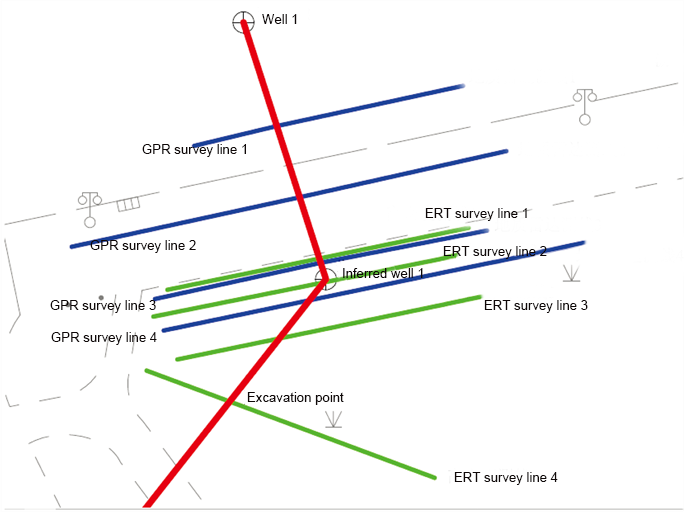
The GPR is model OKO-2 from Russia (150 KMHZ) with 4 survey lines, the line 1 and line 2 is on cement road, line 3 and line 4 is on green belt.
The 2D high-density system is WGMD-4 2D ERT System from BTSK, China with 30 take-outs, 0.5m space.
-
The survey line 1 (Fig. 6) with obviously high resistivity underground 7~8m, the apparent resistivity is about 50Ω∙m, depth is 1.3m, which is similar with the GPR result, it presumed to be the detected pipeline
-
The survey line 2 (Fig. 7) is parallel with survey line 2, which also with obviously high resistivity underground 7~8m, the apparent resistivity is about 50Ω∙m, depth is 1m.
-
The survey line 3 (Fig. 8), the abnormal high resistivity is about 5 m (white box), depth is 1.3 m, the apparent resistivity is about 50 Ωm, the location of the pipeline is related to the geology Radar deflection results in contrast to the pipeline position.
-
The survey line 3 (Fig. 9), the abnormal high resistivity is about 5 m (white box), depth is 1.5 m, the apparent resistivity is about 50 Ωm, the location of the pipeline is related to the geology Radar deflection results in contrast to the pipeline position.
-
The position of the pipeline is deflected in comparison with that of the ground radar. It is inferred that the direction of the well pipe is deflected when the original pipe enters the green belt. Respectively, the geological radar line, line two, high-density electrical line three, line four obtained line extension, get the intersection of the green belt within the unknown well location. According to the construction needs, high-density electrical method in the four-meter location artificial excavation, excavation of 1.6 m in the buried depth of the sewer, and the detection results are consistent, be confirmed.
4 Method comparison
From the plane location map of the survey area, it is known that the geological radar line 1 (Fig. 2) and the survey line 2 (Fig. 3) are located on the cement road, the ground layer is good, the underground medium is close, the electromagnetic wave decays slowly, the underground pipeline and the surrounding medium Dielectric constant difference, a better reflection of information. High-density electrical method in the cement road with a poor conductivity, which is not so good.
ERT survey line 1 (Fig. 6) has the similar location with GPR line 3 (Fig. 3), but in green belt. The high density survey with a good conductivity and good result in greenbelt, which is easy to determine the location of pipeline.
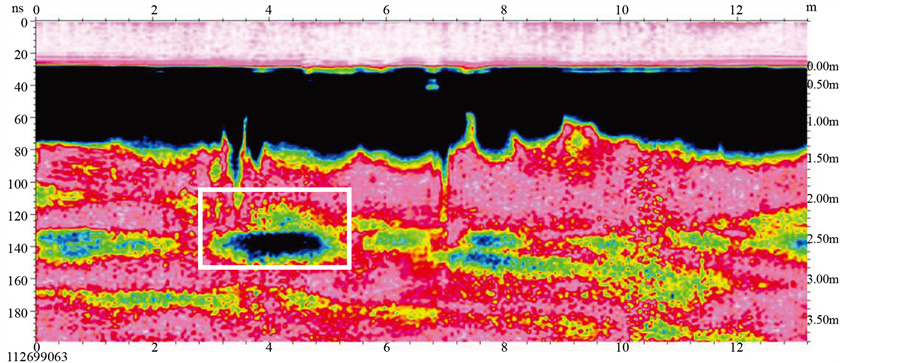
Figure 2. Geological radar line 1
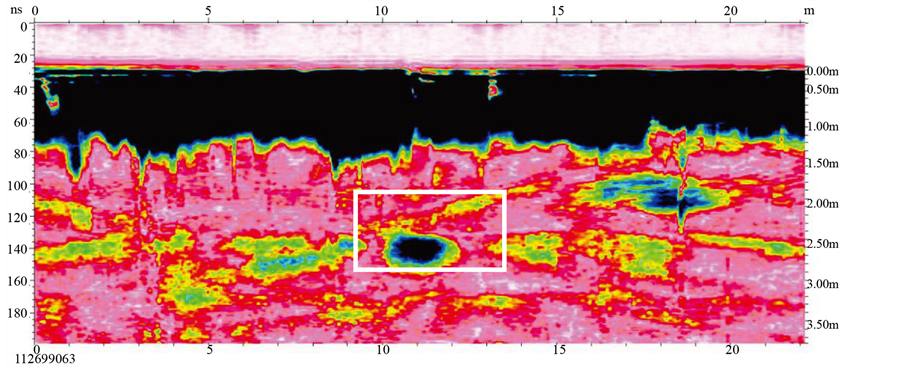
Figure 3. Geological radar line 2
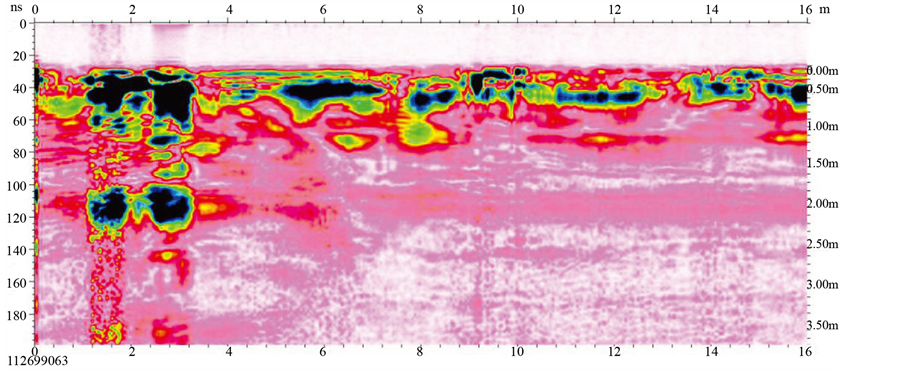
Figure 4. Geological radar line 3
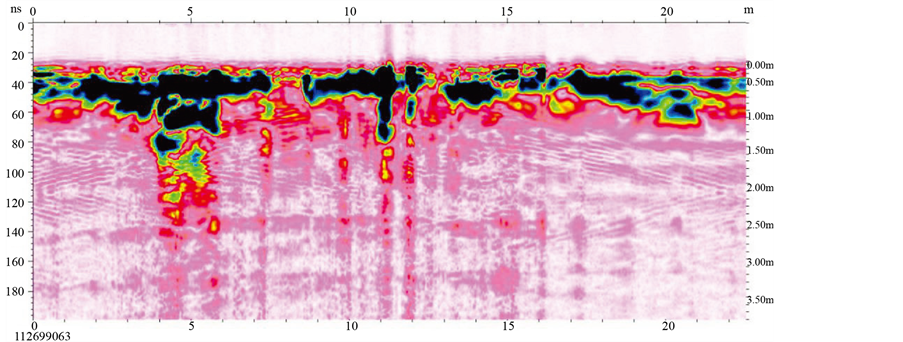
Figure 5. Geological radar line 4
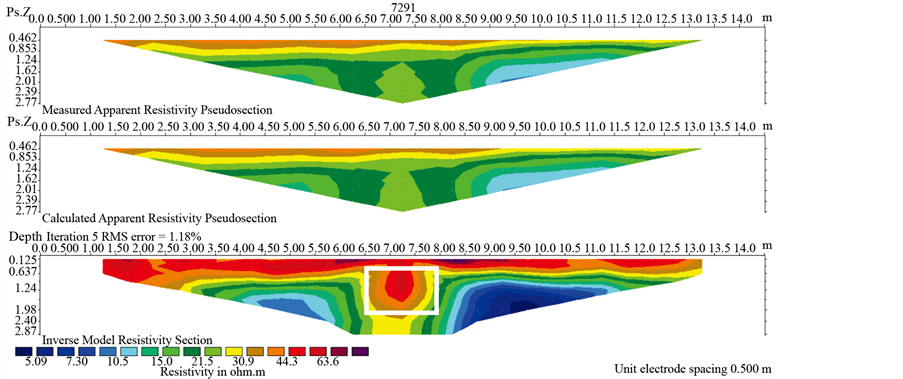
Figure 6. High density electrical method of line 1
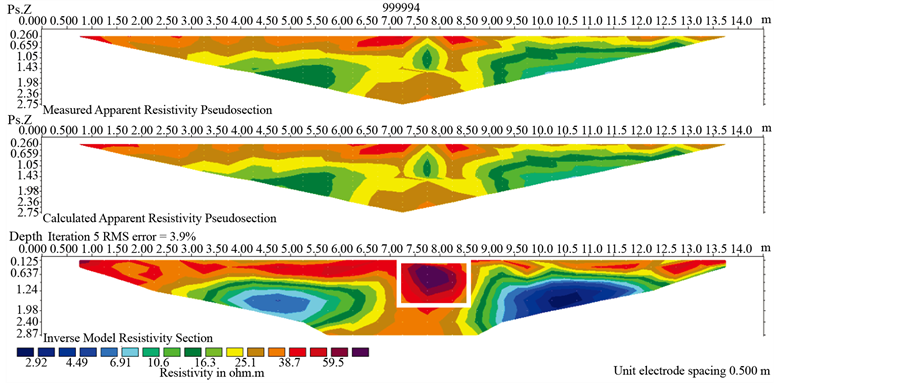
Figure 7. High density electrical method of line 2
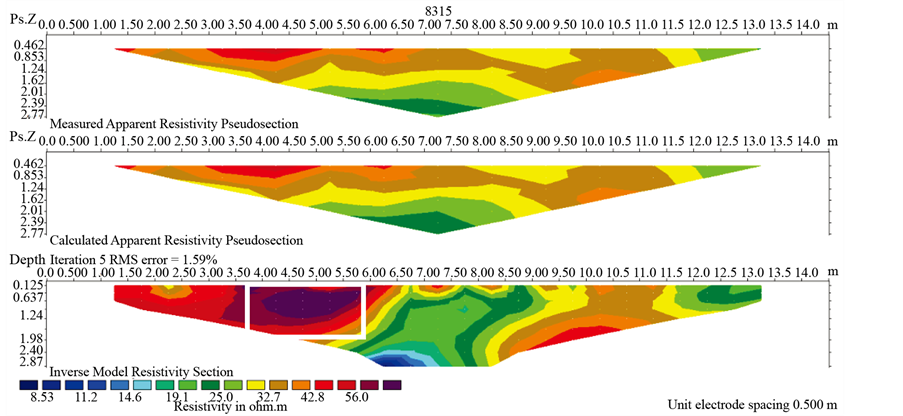
Figure 8. High density electrical method of line 3
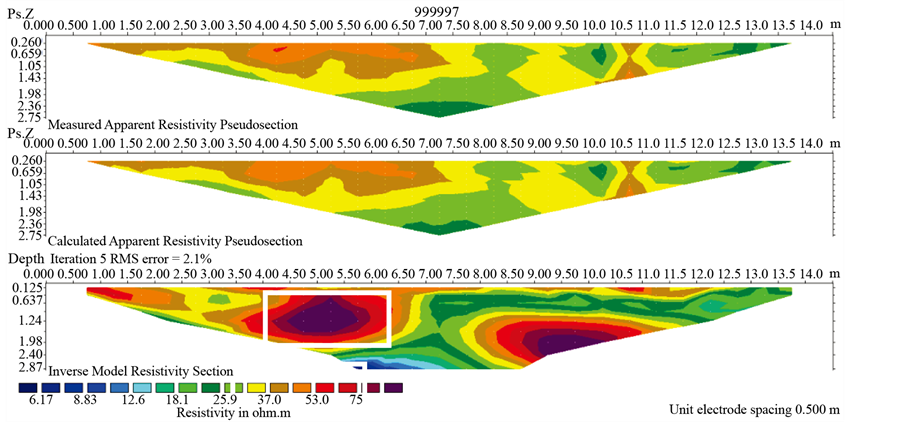
Figure 9. High density electrical method of line 4
5. Conclusion
Detect underground pipeline belongs to geophysical engineering exploration, geophysical exploration is basis on the physical differences, such as density, permeability, resistivity and so on. Any detection method is limited, only in certain conditions and scope of application. A variety of detection methods can take the advantages of different methods.
The ground penetrating radar (GPR) is applied to the flat road, the surface medium of which is dense and uniform, and the dielectric constant is different between the object and the surrounding medium. The high-density electrical method is suitable for the area with good conductivity and resistivity difference with surrounding medium. It is an integrated geophysical development trend to adopt suitable geophysical methods to solve engineering problems.








